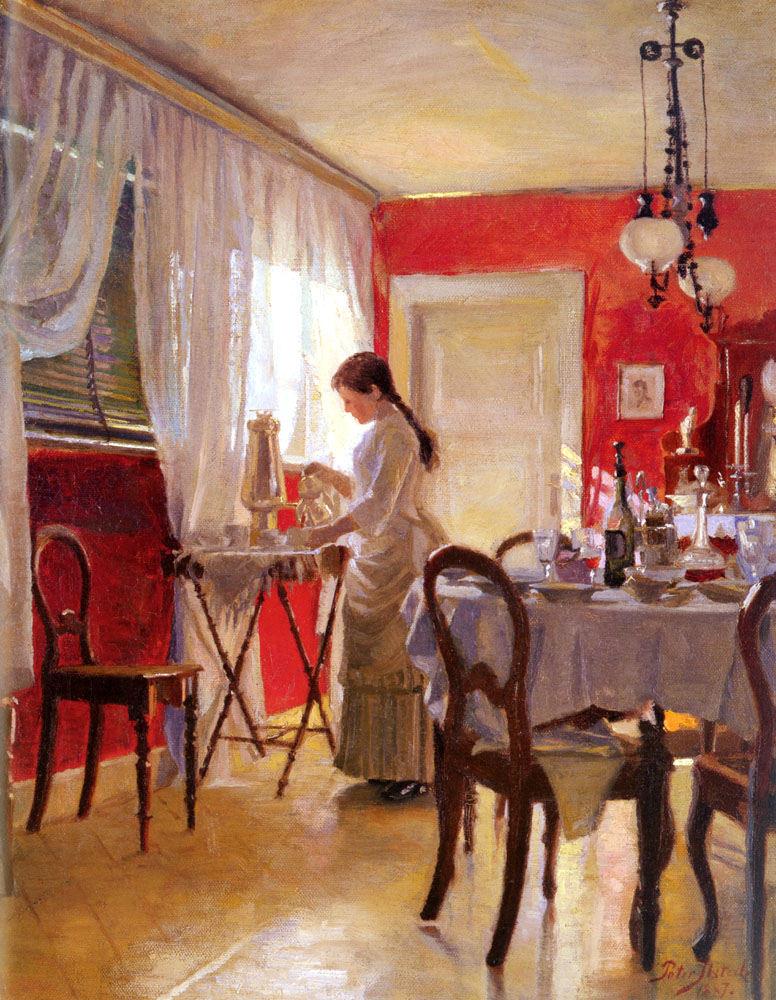The Industrial Revolution changed the world in many ways. It brought capitalism and consumerism into being, changing the world’s outlook on wealth creation. It revolutionized technology, allowing the innovation of mass production to expand exponentially. Jobs in factories shifted labor from farming to factories. With this came the migration of people from countrysides into cities as the economy shifted from an agrarian society into an industrialized society. This shift altered the social structure of the family. Beginning in the early nineteenth century, as the effects of the Industrial Revolution began to settle, a pattern became visible. With the rise of industrial labor, men transformed their function from director of work to provider of income, developing their role in the public sphere as laborers and professionals. Meanwhile, women took on the role of educating the children and keeping the home in order, forming the private sphere within the household.1
Historians argue over how we should understand these separate spheres. Some argue that working-class women had to participate in the public sphere out of necessity for earning a living, and therefore they were denied the choice of participating in the cult of domesticity.2 They argue that although these women’s position in society was marginal, they created an identity for themselves in the public sphere.3 While these historians claim that participation in the cult of domesticity was restricted to middle-class women, I argue that working-class women, when they had the choice, often chose to work in the private sphere, thereby choosing to participate in the cult of domesticity to the best of their abilities.

As the Industrial Revolution changed the mold of society, the public sector and the private home became two isolated and separate worlds. The private sphere of influence that women were associated with in the nineteenth century refers to the realm in which a woman’s role was as the head of the domestic household. In contrast, men participated in the public sphere, which included the worlds of labor, politics, and association.4 In her role in the private sphere, a woman determined the social reproduction aspect of the family, as opposed to the economic production. Social reproduction is defined by feminists as the labor involved in the maintenance of a lifestyle as well as producing the next generation.5 This work goes beyond bearing children, including activities such as making food, clothing, and shelter immediately available; teaching and caring for children; caring for the elderly; and providing a good moral example within her home.6 From an early age, girls’ education centered around making good wives and mothers with programs that guaranteed gentility and femininity. By participating in such activities, women helped to form the organization of society through their families. While the class of their families contributed to the flexibility of their appearance in the public sphere, there is a clear distinction between public and private worlds.
The newly formed middle class of the nineteenth century is the most overwhelming indication of the separation of spheres. With industrialization on the rise, clear gender roles emerged as the social structure of the family changed.7 Whereas in the working class both women and men contributed to the family income, in middle-class families the men worked for wages while their wives stayed home to manage the household.8 This gave women of the middle class little opportunity to participate in the public sphere. A clear indicator of middle-class status was the ability to keep any number of servants. Most families had only one servant.9 Nevertheless, it was the women of the household that directed their work in their homes. This was the contribution they made to their household. The occupation of homemaker, though valuable to the family, cemented their lives in the private sphere. Mothers were expected to provide for the education of their children. It was because of this ideology that middle-class women were able to be educated in math, literature, history, and foreign language, and to teach their children in turn.10 As daughters grew up, the limited education they received was the basis for wives and mothers to properly fulfill their roles, teaching their children as the cycle of domesticity repeated itself.

Due to their economic need to work, working-class women had more of an opportunity to be in the public sphere. In order to survive, these women, as laborers, interacted with employers, landlords, police, and other public institutions such as schools.11 This blurred the line between the private and public spheres. It was for this reason that working-class women were seen as hostile and aggressive. Although they did have interactions in the public sphere, this conflicted with their assigned role as caretakers. In order to do what was necessary to provide for their families, they were perceived as risking their moral virtue by entering the public sphere. With this morality at stake, it was easy for society to question these women’s ability to care for a household when the private and public spheres were viewed as being so isolated from each other. Thus, being employed in a factory, or another public institution was viewed as unfavorable to working-class families seeking jobs for their daughters. These daughters were to grow to become the wives and mothers of the next generation, so they needed to be viewed with the capability to support domesticity. Therefore, when women had the choice, these young women often chose to be employed as a servant, which was a less humiliating alternative to factory work.12
These young, working-class women helped their families by earning income while remaining in the private sphere. Their class status remained distinctly working class, as it was the distinction to hire a servant in the first place that separated the middle class from the working class. But even when a working-class daughter or wife needed to contribute to the family’s income, if she chose to work as a domestic servant, her could remain largely in the private sphere, although in the private sphere of another woman’s home. An 1891 study shows that out of the 772 domestic servants working in Lancaster, only eight were men.13 Clearly there is an overwhelming difference in number of female servants as opposed to male domestics. Thus, by the Victorian standards that fostered the separate spheres sensibilities, these working-class women were subsequently choosing to remain in the private realm. The same study shows that the majority of servants were young single women. This indicates that these women were preparing for their lives as wives and mothers by supporting their father’s household through work in a private home.14 It further shows that young women worked in factories and entered the public sphere only when absolutely necessary.

Through the examinations of the work that women of the lower and middle classes contributed to their families, there is a clear distinction that emerged in contrast to their husbands and fathers. While middle-class women dedicated their lives to their work in the privacy of their homes, working-class women were required to roam the male-dominated public sphere by working. Still, a clear distinction emerges, as working women often chose jobs in the homes of the wealthier classes. Through this evidence, I have argued that women most often sought to remain in the private sphere, either as middle-class women or as working-class servants, while their husbands and fathers worked to provide for their families economically. Therefore, despite the claim that participation in the restrictions of the private sphere pertained only to the middle class, it is clear that working-class women often chose to work in the private sphere rather than in the public eye.
- Barbara Laslett and Johanna Brenner, “Gender and Social Reproduction,” Annual Review of Sociology, vol. 15 (1989): 387. ↵
- Amanda Vickery, “Golden Age to Separate Spheres? A Review of the Categories and Chronology of English Women’s History,” The Historical Journal, vol. 36, no. 2 (June 1993): 389. ↵
- Ruth L. Smith and Deborah M. Valenze, “Mutuality and Marginality: Liberal Moral Theory and Working Class Women in Nineteenth Century England,” Signs, vol. 13, no. 2 (winter 1988): 278. ↵
- Ellen Jordan, “‘Making Good Wives and Mothers’? The Transformation of Middle-Class Girls’ Education in Nineteenth-Century Britain,” History of Education Quarterly, vol. 31, no. 4 (Winter 1991): 443. ↵
- Barbara Laslett and Johanna Brenner, “Gender and Social Reproduction,” Annual Review of Sociology, vol. 15 (1989): 385. ↵
- Ellen Jordan, “‘Making Good Wives and Mothers’? The Transformation of Middle-Class Girls’ Education in Nineteenth-Century Britain,” History of Education Quarterly, vol. 31, no. 4 (Winter 1991): 442. ↵
- World History Encyclopedia, 2011, s.v. “The Cult of Domesticity in the United States and Britain.” ↵
- Barbara Laslett and Johanna Brenner, “Gender and Social Reproduction,” Annual Review of Sociology, vol. 15 (1989): 389. ↵
- Siân Pooley, “Domestic Servants and Their Urban Employers: A Case Study of Lancaster, 1880-1914,” The Economic History Review, New Series, vol. 62, no. 2 (May 2009): 407. ↵
- Ellen Jordan, “‘Making Good Wives and Mothers’? The Transformation of Middle-Class Girls’ Education in Nineteenth-Century Britain,” History of Education Quarterly, vol. 31, no. 4 (Winter 1991): 442. ↵
- Ruth L. Smith and Deborah M. Valenze, “Mutuality and Marginality: Liberal Moral Theory and Working Class Women in Nineteenth Century England,” Signs, vol. 13, no. 2 (winter 1988): 286. ↵
- Siân Pooley, “Domestic Servants and Their Urban Employers: A Case Study of Lancaster, 1880-1914,” The Economic History Review, New Series, vol. 62, no. 2 (May 2009): 418 ↵
- Siân Pooley, “Domestic Servants and Their Urban Employers: A Case Study of Lancaster, 1880-1914,” The Economic History Review, New Series, vol. 62, no. 2 (May 2009): 411. ↵
- Siân Pooley, “Domestic Servants and Their Urban Employers: A Case Study of Lancaster, 1880-1914,” The Economic History Review, New Series, vol. 62, no. 2 (May 2009): 411. ↵



63 comments
Gabriella Parra
This is such an interesting article! While reading, I kept thinking about how much of a choice working-class women had to work in the domestic sphere. On one hand, they probably had very few options of employment and choosing to work in the private sphere could be seen as an act of autonomy. On the other hand, if they worked in the public sphere, they would be ridiculed by others and likely have a difficult time securing their futures as a wife and mother who stayed in the domestic sphere.
Jared Sherer
The author did a good job explaining how the middle class would be the main push throughout the Industrial Revolution, with women playing a central role. Learning about the private lives of the middle class and how women had to choose whether to work in a public job or for a private employer, was fascinating. The struggle of working class women of that era to work outside the home, to provide needed income, but remain in the private sphere, is made very poignant. It was a real struggle brought to life by the author. Ms. Valdez did a good job and showed a lot of effort in this article along with great learning points and well developed information that keeps the reader interested. The writing style was excellent and it was an easy and informative article to read.
Barbara Ortiz
Great Article Teresa. I enjoyed reading this evolution for woman’s roles in the home and workforce. One thing I found interesting in your article was that this is when the middle class grew from, and that there was a significant difference between the working class and middle class. I feel very different from today since I view today’s middle class as a working class.
Eugenio Gonzalez
The article was very informative. Learning about the struggles and roles of women and men from the lower and middle classes was interesting. It is intriguing how the role of women in society has evolved for good. The article does an excellent job of demonstrating how the middle class would begin to rise and feel superior to the lower class.
Anayetzin Chavez Ochoa
I wonder why the private sphere was restricted to middle-class women as if coming home with money for the family isn’t domestic in its intent. This must be part of the solidified stereotype that women are caregivers in society because of the imposed responsibilities for the domestic woman (not as expected, but actually enforced as a bubble in which working-class women could not “achieve”). Of course, the ladies forced to take care of their households like men were viewed as aggressive because “men do the heavy lifting” and the men ruling the society viewed their own as aggressive and hostile (that’s my theory anyway). Thank you for writing this article! I enjoyed it!
Jacob Adams
I recently read an article about 5 minutes ago on the death of guilds during the industrial revolution. This article however focused on the middle class that emerged in result of it. The middle class became the legs that kept the table of society up. Clear gender roles emerged as well. I found it interesting that women had to become educated as a necessity to instruct children. This is what probably caused women to stand up for their basic human rights. This article had great photos and sources that kept me engaged throughout the reading.
Sofia Perez
Hi Teresa, very interesting article! I did not know about gender norms during the Industrial Revolution. Compared to today, the majority of women do work and have a job. During the Industrial Revolution, men were seen as the head of the household and made all the money; whereas women did not or were just starting to work. I found it interesting that the majority of the women that worked in private spheres as domestic servants were young females.
Adelina Wueste
This article brought attention to a very different aspect of the industrial revolution. This article introduces a time when it became more evident that women were becoming more equal to men. What’s interesting to me is to see that the equality came out of necessity. Women in lower classes had to work which brought them out of their more domestic roles. What’s interesting about your article is that you mention how despite women beginning to work, women still worked in the private spere rather than the public spere with more men. Despite the fact that women worked out of necessity, women worked in positions they were comfortable in like the private spere.
Jaedon E
Interesting article! I didn’t know during the Industrial Revolution that women were allowed to work just as the men. But not only that but the women were treated less than the average man, due to many reasons. I find it interesting that some women were able to complete tasks that men couldn’t do, instead of just staying home and taking care of the children and cleaning the house.
Great description!
Lauren Deleon
You did a really great job of explaining the shift in family dynamics that came with the industrial revolution. I wonder if the reason that working class women would choose to work in the private sphere if they were given the option, has something to do with the fact that women had the most authority in those areas of life. If they chose to work in the private sphere because in those areas they were treated with the most respect, since the public sphere was so male dominated.